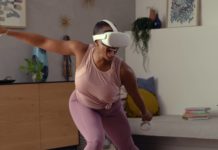It’s likely to be the first of its kind, as it is fully untethered and positionally tracked but is it something worth buying? We’ve seen headsets come out with wireless accessories, but this is one of the first headsets to be fully wireless so let’s see what the Pico Neo CV has got.
A Decrease in Quality
Right off the bat, the displays only provide 1.5k as compared to some of the newer models of HMD’s that we’ve been seeing but that cost isn’t that big. After all, most who have been experiencing VR have either dealt with 720p, 1080p, or 4k supersampling if you want to play around with the big guns. It still comes with built-in speakers, 90Hz display rate, and a rather light build in comparison to other VR HMD’s.
It’s Technically Not Tethered, But it is Tethered
That’s right, Intel actually showed off their version of a fully wireless positional tracking unit during CES but Intel is a major corporation whereas Pico just started off two years ago. As a developer, I prefer Indie made products but Indie refers to developers (individuals) who work on their own budgets rather than a company’s other successes like Google’s VR was built on money made by Google Ads. In this case, the company is still small enough to be called an Indie company while not ticking off a whole bunch of people who have their own conceptualized version of what Indie means. In the tech world, a staff of 500 employees is still kind of a Mom and Pop shop that just opened up another store, which is why the fact that this company is toe-to-toe with Intel with its wireless technology is beyond impressive.
![]()
To be one hundred percent clear, this device runs by itself and does not need a phone or PC to run. The computer is built into the controller and it is in fact tethered to the controller. There will be an option to connect it to the PC, but it can run on its own just fine too. However, keep in mind that it only tracks the turning position of the head and not the actual place of the head so if you go forward it will not recognize it.
Why Indie Products Make The Industry
As mentioned, I prefer Indie products over a major corporation because the Indie community often cares about pushing the boundaries rather than making a feature that will make them more money. It is true that the ultimate goal is to make money, but the purpose is to push the boundaries whereas a company’s goal is usually compartmentalized selling.
![]()
Compartmentalized selling is where you create a bunch of “rule breaking” features but you only release enough of them so that the product looks like it is better than the competition. A good example of this is the PlayStation VR, which is sold as an accessory to their main product. It has just enough to do the job and that’s it with no boundary pushing features beyond that. They know that PlayStation users will buy the product because it means they don’t need to buy or mess with a PC VR environment so they just produced the most bare minimum product that they could. Next year, PlayStation will likely build a
much better one with new features found from this year to go with something else they’re building because they know it will sell well.
A product like the Pico Neo CV is still trying to push the boundaries and get that devout consumer base the big companies have so when they release a product, it is usually the most impressive thing they could make. With a sacrifice on the 1.5k display per eye, which is not really a sacrifice, the device is actually very impressive. It is entirely built-in with the most advanced surround sound system of all the headsets. It has positional tracking and needs no external power supply, which is something few VR HMD’s can boast about.
![]()
While the headset is impressive, it is not available for purchase just yet and we only got to see what it looks like at CES. Regardless, of all the HMD’s found at CES this year, this has to be the best one of them all even if it only winds up being the best one for the mobile market later on this year. Until more specifications are released though, we simply can’t say.





Comments are closed.